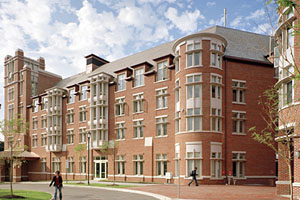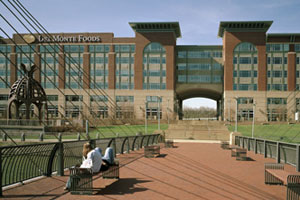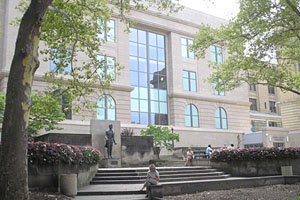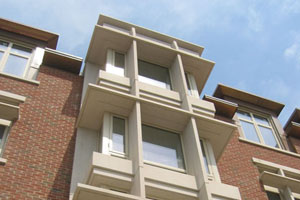More Than Just Architectural Dressing

As most mason contractors are undoubtedly aware, the use of cast stone and manufactured stone in both commercial and residential construction has increased steadily during the past decade. Cast stone producers say the volume of materials being produced and installed in the United States has doubled, while manufactured stone producers report that the stone veneer industry has been growing at an accelerated rate for several years and is projected to continue at a brisk pace into the foreseeable future. In fact, sales of manufactured stone in the United States are projected to reach $900 million by 2009.
The use of cast stone and manufactured stone as an alternative to natural stone has increased in recent years because of the materials' economy, designer freedom and universal availability. With the increased use, a highly specialized industry has developed.
According to the non-profit Cast Stone Institute, cast stone offers many advantages when compared with natural stone.
- It can be integrally reinforced with steel and precisely colored through aggregates or mineral oxides.
- Mix designs have tested engineering values, which result in a predictable, durable life.Because the manufacturing process is controlled, strength and weathering qualities are consistently better than natural stone.
- Repetitive treatment, either as trim or ornament, can be achieved quite economically.
One example of this can be seen in the company's work with the Summit County Courthouse in Akron, Ohio. In selecting cast stone, county officials saved taxpayers about one half of the cost that would have been required to construct the facility with natural limestone, which is the main material surrounding other buildings in the existing complex.
Cast stone can also become a problem solver in projects where quick turn-around times or design considerations make natural stone hard to use.
One recent project earned American Artstone Co. Inc. of New Ulm, Minn., two 2006 Cast Stone Institute Excellence Awards for the large cast stone pieces provided for the Case Western Reserve University's seven dormitory complex in Cleveland. Nancy Fogelberg, CEO of American Artstone, said that the building didn't have the structural steel required to hold individual pieces for the elaborate bay windows, so they had to make the bay windows in one piece to connect back to the building.

"We can mimic stone that is no longer quarried or very expensive," Fogelberg said. "We can give you something that looks almost spot-on or very close to that. And because it is man-made, we have some control over it, and that typically lasts longer."
American Artstone has extensive experience in the restoration and rehabilitation of aging structures built with natural cut stone. Fogelberg recalled one restoration project where a series of carved-stone gargoyles needed to be restored. "There was a courthouse in Winona, Minn., that was built in the 1880s, and through some unfortunate circumstances, sealant was put on the stone that trapped moisture inside," she explained. "So these beautifully hand-carved, decorative stones — and the gargoyles were part of them — were disintegrating. They took the pieces off and shipped them to us. ... We hired an artist and he restored [the gargoyles], and we made rubber molds from them and then cast it from there."

All of these advantages combine to make manufactured stone one of the most rapidly growing building material products available. According to Bob Heath, marketing leader of Toldeo, Ohio-based Cultured Stone Corporation, "The use of stone has continued to expand, and we enjoy stone being used as a major design element in both residential and commercial, and remodel work. But we also are enjoying use as an accent material with other types of exterior cladding materials."
Through advances in manufacturing technologies, fabricated stone products have steadily improved in appearance to mimic natural stone. According to Glenda Starkweather at Boulder Creek Stone Products of Minneapolis, with the technology in the type of molds that Boulder Creek and other manufacturers use, "You're able to get the slightest little detail imprinted in the stone. In the beginning, you couldn't reproduce the hairline details that natural stone has, but technology has allowed us to incorporate that, as well as the colors and other details that people like."
The seemingly endless color possibilities and the level of detail that is achievable are two, main reasons for the material's popularity. This potential differentiation in curb appeal is what people are after. Starkweather said that today's customers don't want their homes or businesses to look just like their neighbors'. "Basically, brick looks all the same; stone allows them to be an individual," she said.
Indeed, design variation is key to this material's success, and the market is driven by new product development. "With a constant flow of new products over the years, we've been able to allow people to come up with a fresh look, a fresh design, and keep adding to that," Heath said. "If you wanted to look back a couple of decades, the product offering is probably ten times what it was back then." He stated, "there is actually more manufactured stone veneer being used in the marketplace than there is natural stone thin veneer."

For the benefit of mason contractors, Veneerstone's business model emphasizes maintaining large, on-hand inventories to permit mason contractors to complete projects quickly, according to Muratore. Further, Muratore added, "Our packaging allows more product to be delivered at one time, lowering freight costs and minimizing damaged product in shipment."
Similar to Veneerstone, Cultured Stone is carving a new niche market for its manufactured stone products. Bob Heath, Cultured Stone's marketing leader, said of the company's new Monticello Trim collection: "We've created our own myriad of detail products. We've taken care of the details with a masonry product that is easy to install, that you can use to actually add architectural impact to your design." Heath said that it is installed as an adhered veneer, but gives end users the look of dimensional, natural stone.
Today, the manufactured stone industry is going well beyond just replicating the look of natural stone. Companies, such as those mentioned above and many more, are creating products that the market demands — new sizes, designs, shapes, colors and more.
- Have complete mortar coverage on the back of the stone.
- Bonding agents are relatively inexpensive insurance when applying manufactured stone to pre-existing masonry surfaces or installing dry stack stones (mortarless joint applications).
- Crew members new to manufactured stone tend to make the mortars too dry. Add enough water to get the mortar to the consistency of thick cake batter to aid in the adhesion of the stone to the wall.
- Try installing the manufactured stone from the top of the wall down to the bottom; it makes for a cleaner installation and cuts back on job cleanup.
About the Author
Cory Sekine-Pettite is an editor for Lionheart Publishing and was the founding editor of Masonry Design magazine.


















